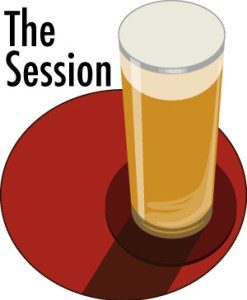 I have long had a fondness for ‘brown’ beers of many descriptions: dark milds, schwarzbiers, porters, dunkels, and, of course, your better-than-average brown ale (either theoretically British or American – I know I should like a good Oud Bruin, but it’s just not my thing in quantity). And, once upon a time, brown ales loomed large on the beer horizon. Newcastle Brown Ale was widely available, and Pete’s Wicked Ale was the go-to American version of the style. Cast your mind back to a differently-benighted America in the early 1990s; while there were a few interesting regional beers, nationally-available ‘microbrews’ (as we used to call them) were few and far between. If you weren’t a lager fan – and you might have over-corrected in your dislike of the macro-brewed ‘lager’ offerings to ignore Sam Adams – your options were relatively limited. Your ‘import’ choices tended to be pretty straightforward British beers: Newcastle Brown, Samuel Smith’s Oatmeal Stout and the like. These were presumed (at least by me, in my inexperience) to be vastly superior offerings – they had color! Flavor! Exciting times.
I have long had a fondness for ‘brown’ beers of many descriptions: dark milds, schwarzbiers, porters, dunkels, and, of course, your better-than-average brown ale (either theoretically British or American – I know I should like a good Oud Bruin, but it’s just not my thing in quantity). And, once upon a time, brown ales loomed large on the beer horizon. Newcastle Brown Ale was widely available, and Pete’s Wicked Ale was the go-to American version of the style. Cast your mind back to a differently-benighted America in the early 1990s; while there were a few interesting regional beers, nationally-available ‘microbrews’ (as we used to call them) were few and far between. If you weren’t a lager fan – and you might have over-corrected in your dislike of the macro-brewed ‘lager’ offerings to ignore Sam Adams – your options were relatively limited. Your ‘import’ choices tended to be pretty straightforward British beers: Newcastle Brown, Samuel Smith’s Oatmeal Stout and the like. These were presumed (at least by me, in my inexperience) to be vastly superior offerings – they had color! Flavor! Exciting times.
Moving to the UK in the mid-’90s quickly taught me that while there were certainly good things about British music and television, there was just as much that was terrible as there was in the US; it was just that the worst (and some of the best) never made it abroad. This rule applied equally to beer – I discovered that ‘the good stuff’ was often simply from a local family brewery, and they didn’t always make enough to export. But I loved my go-to beers, even if they weren’t ‘fancy’ – a pint of Theakston’s Best, Brains Dark, Moorehouses’s Black Cat, Lancaster Bomber (the version from the 1990s, not the current iteration, which seems much changed). I tended to go for beers on a chestnut-to-dark-brown continuum, and while I do go for more variety today, overall, that pattern still seems to hold.
Even back in the US in the dead-end of the millennium, the Mountain View Small Brewers’ Fest featured a wide variety of copper-to-black beers of varying quality, not infrequently named after less-renowned Tolkien characters, though this is to be expected when software engineers have side projects. Shortly thereafter, the American beer scene exploded – microbrews became ‘craft beer’ and bitters, stouts and porters began to play second fiddle (or perhaps eighth oboe) to IPAs. ‘Boring’ brown beers began to disappear – milk stouts were booted for coffee stouts, and everything else on the amber-to-brown spectrum seemed to end up aging in or on oak. Fortunately, though, the pendulum for extremes seems to have shifted slightly – sure, it’s nice to have some of the more extreme stuff from time to time, but on the whole, it’s lovely to have beer that tastes like beer.
Of late, there are few things I enjoy more than a toasty, biscuity ESB or a roasty – but not too roasty – mild, but they are relatively few and far between in the Pacific Northwest; granted, we have great IPAs, but the ubiquity of great IPAs also means we are awash in mediocre ones, since nearly everyone feels they need to make one to compete for tap space, even if they aren’t particularly successful at it (and they are probably correct). There are a few local standouts that do fit the bill for this discussion, however – Lower Case Brewing’s ESB is very fine indeed, and I recently had an excellent, straight-up brown ale called Betsy’s Mountain Brown at Naked City Brewery a few neighborhoods over from ours. Perhaps because they grew out of the 1990s microbrew tradition that was more influenced by British pubs than (often wonderful) Belgian oddities, Seattle’s brewpubs tend to have a much wider variety of the sort of solidly-made, eminently quaffable ESBs, porters and stouts than many of the more buzzed-about small breweries – or maybe they simply assume a fairly large percentage of their clientele will be there for a meal with the family, and a tap list of 12% tequila-barrel-aged strong ales doesn’t suit all palates or occasions. So, with little fanfare, many are consistently turning out great coppery altbiers, dark caramel ESBs, deep ruby-brown porters and nearly-burnt-toast dunkels.
Long may they continue – and here’s hoping more of the ‘edgy’ breweries also opt to show off their skills with a few subtle brown beers.
And thanks to Joe Tindall for hosting The Session this month; I’ll be raising a glass of something coppery to you for prompting me to get back to regular-ish beer writing.
1 thought on “The Session #120 – Brown Beer, At Home & Abroad”